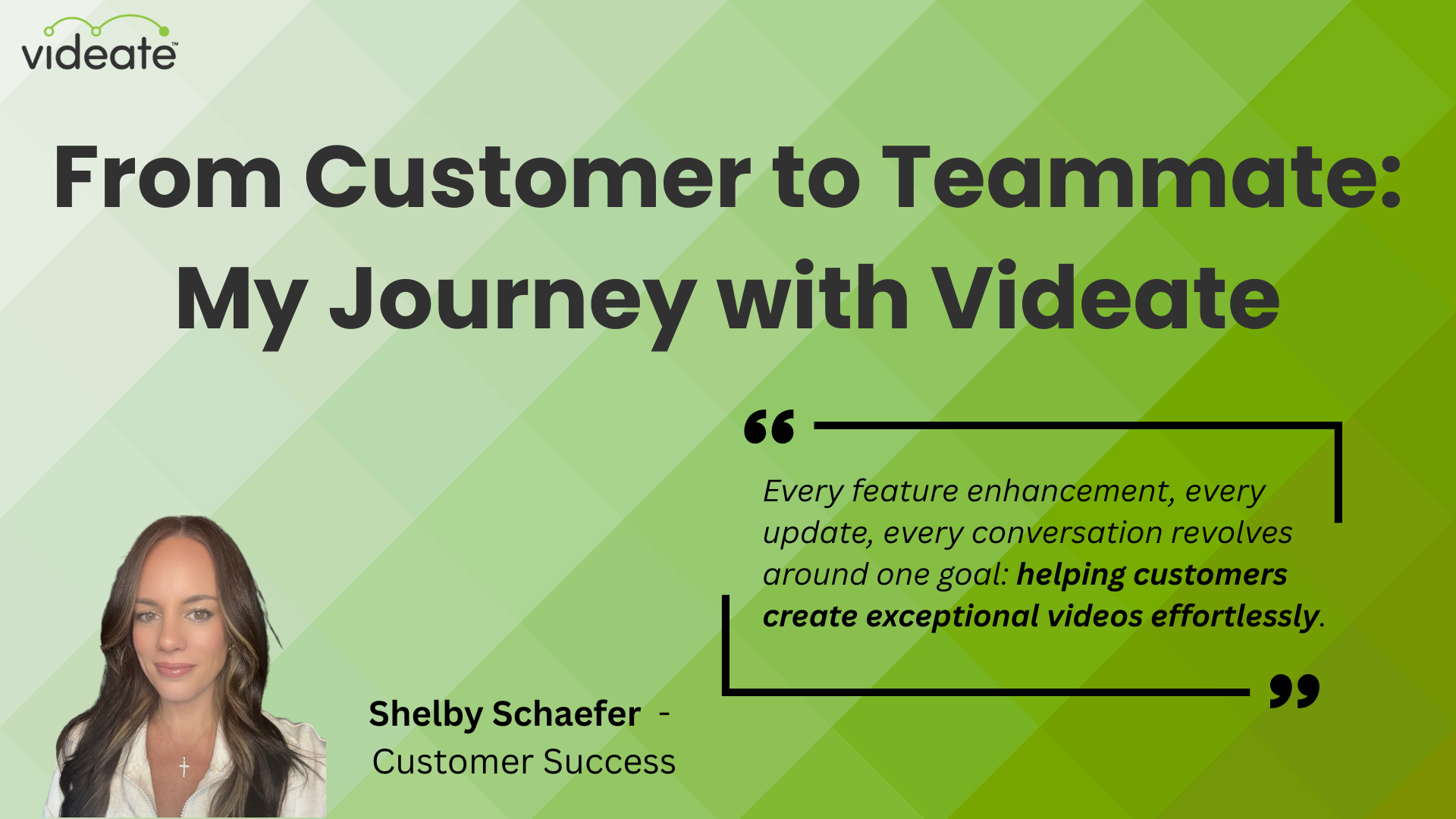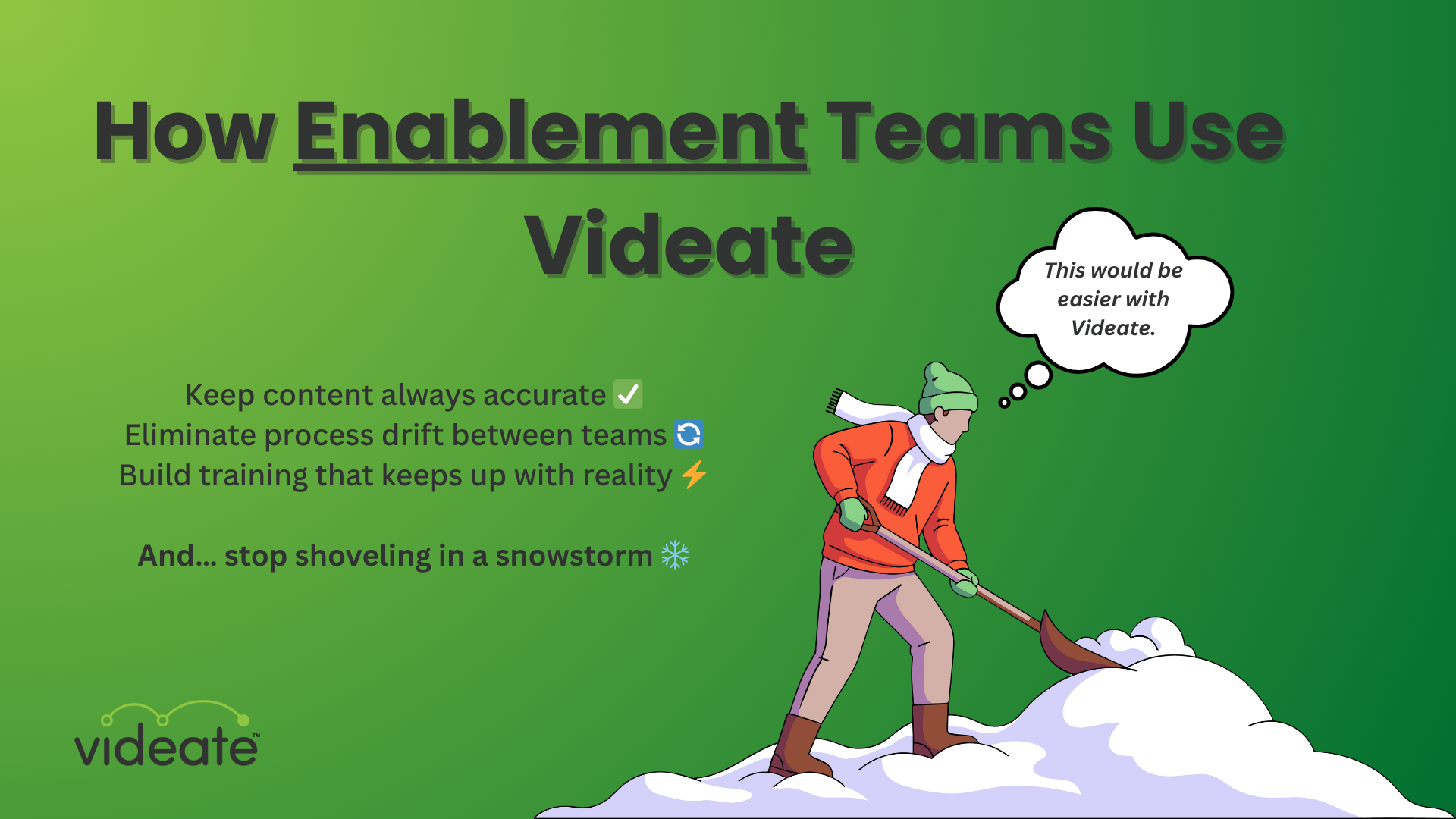4 min read
Top trends that are changing the face of Instructional Design for SaaS
Videate Jul 26, 2022

You broke a doorknob. You find two videos on how to fix it.
One is two hours long. It goes into the origin of doorknobs, different types of doorknobs, the cost of doorknobs, great doorknobs in history, how the instructor got into doorknobs and all the different ways you can fix a doorknob.
The other video is less than a minute and teaches how to fix your specific doorknob problem.
Which do you choose?
Even the biggest doorknob fan in the world would pick the shorter video. Why? Because they want the doorknob fixed and they want to move on with their life.
This is why Instructional Design (ID) is trending towards a focus on value. Providing the information users want to know, quickly, rather than teaching everything they should know.
And SaaS companies, who have access to all the user engagement metrics, are starting to take notice. They're making big changes to how they approach instructional design.
Here are the major instructional design trends impacting instructors and customers.
It’s not Customer Education – It’s Customer Success
The function of Instructional Design is moving from Customer Education to Customer Success. This means different goals.
With customer education, the aim is to fill the customer in on all the amazing features of your product or service. With customer success, the aim is to make the customer successful with what they want to do.
Dave Derington of Customer Education states, “Content is not educating at every feature… SaaS companies that are really performing at a high level of quality in instructional design have developed content that focuses on the value first. ‘How can I do X? That’s all I want to know.’ Get in, get out.”
Younger workers say that learning is what makes them happiest at work – but it has to be learning in their own time, in their own way, about what they deem is relevant. The modern learner can be difficult to reach, if you don’t understand what they want.
For SaaS, the goals are always customer retention, increasing renewals, boosting lifetime customer value, and decreasing churn. The best way to do this is to have customers find success in what they’re doing as quickly as possible. In doing this, companies show respect for a customer’s time, and limit frustration.
This means focusing on the efficiency of learning materials. For example, if you look at the completion rate of a video and notice that viewers average only 40% of the video, some may say that it failed as a learning tool.
But, what if viewers stopped watching at 40% because they got all the information they needed and then applied it to their task?
In this case, measuring for the completion of the task (or continued use of the product or service) would be a more accurate measurement of success.
So, while Customer Education may focus on the breadth of the curriculum, Customer Success focuses on how the materials are impacting customer retention.
As Deringer states:
What we’re doing is we’re changing the kinds of roles to focus on value… ‘What effect (did this module) have on product usage?’ We can measure that. …(T)hat’s a huge trend. It means platforms and technologies that have measurements involved are going to be more received and used because… instructional designers are going to need to know how that is performing.
Be a customer influencer, not trainer
A large part of modern instructional design is the move towards asynchronous learning. Asynchronous learning means learning at one’s own pace, in whatever order a learner deems fit. There is less reliance on in-person learning or online courses that emulate classroom environments.
Deringer told Videate, “We are at the precipice of a change on how we do education. Traditionally, we would come in, bring a book, sit in a class… Now we have to be a lot more ‘YouTube-y’. ‘TikTok-y’. Smaller bites. Stuff that’s going to get people’s attention.”
For SaaS education design, that means thinking of yourself as a customer influencer. Create content that is short, sweet, fun, and relevant. Utilize microlearning videos, which distribute lessons in tiny, bite-sized learning units.
Having shorter videos gives two immediate benefits:
-
They are more likely for viewers to watch and learn from.
-
They are easier to scale and update. This means viewers learn at their own pace, and companies can easily keep them up to date with software releases and features.
Instructional designers for SaaS should look themselves more as customer influencers than educators. Of course, that doesn’t mean that they shouldn’t teach. It simply means that they need to focus on engagement. Find ways to connect with your base through customer relevance and your own excitement for the lesson.
According to Deringer, cutting edge trends will not be found in academia, the tech field, or from marketers. They will be found on YouTube and TikTok..
Gamification to increase engagement
A major goal of all instructional designers is to foster curiosity. And for modern learners this means learning about whatever their curiosity takes them to. So, SaaS curriculum must meet them there.
In addition to microlearning, SaaS instructional design can also focus on Interactive Learning and Gamification.
Interactive learning allows students to actively interface with the material. Instead of simply watching a video, there could be fun tests on the concepts. Or, they can manipulate visual concepts with controllable 360 degree views, or drag and drop objects into and out of schematics.
Going back to the doorknob example, a viewer can practice disassembling and fixing the doorknob virtually before they do it in real life.
Gamification is another great way to boost viewer engagement. Allow learners to earn badges, points, or other rewards for completing lessons. For more creative Instructional Designers, they can gamify the entire process with a playable landscape for avatars to explore.
The important thing is to make your lessons palatable, because if it doesn’t bring people in, there’s no point in doing it.
Keeping videos up to date with the latest software release
Now you know what kind of instructional design to pursue, but most companies still struggle to produce software videos and keep them up to date.
Add in continuous delivery environments with frequent releases and you’re looking at a significant challenge.
You may have difficulty:
- Creating a complete library of software videos across all desired use cases
- Keeping videos up to date as features change in new releases
- Producing and maintaining videos in multiple languages
Videate was built specifically to solve these problems. And we do it better than anybody.
Creating a video using manual screen recording and editing software takes days.
With Videate? It takes minutes.
Learn how we can help: Why Videate
.png)
How Customer Success & Education Teams Use Videate



